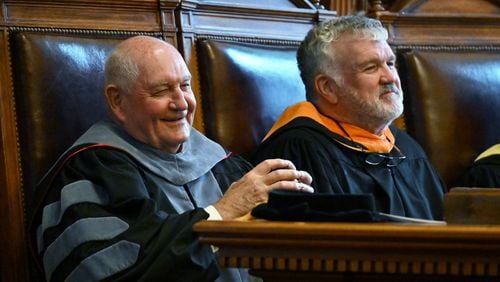We typically talk about dropout rates in relationship to high schools but a new study targets four-year public campuses and takes aim at Georgia’s overall rate of college completion.
Using data from the U.S. Department of Education's College Scorecard, Third Way, a self-described Washington centrist think tank, found 88 percent of four-year public schools in Georgia qualify as dropout factories -- fewer than 66 percent of their students graduate within six years.
The new report, "What Free Won't Fix: Too Many Public Colleges are Dropout Factories, examines the broad questions of college costs and outcomes.
Nationwide, there are only 80 schools (15 percent of four-year public colleges) where two-thirds of first-time, full-time students earn a degree within six years. The study warns, "The graduation rates of the remaining 455 schools are so low that if they were high schools instead of colleges, they would be flagged as dropout factories and be required by federal law to intervene to improve their completion rates."
And the report says the cost of college did not align with outcomes: The average top-quartile school (those with good outcomes like completion, earnings, and repayment rates) charges a net annual price of $10,176, while the average bottom-quartile school (those with the worst outcomes) charges nearly $600 more ($10,762) per year.
An interesting comment from the report:
Today, more than 6.8 million students attend four-year public institutions, making up nearly two-thirds of the entire bachelor's degree-seeking population in the United States. Close to two-thirds of all students attending these schools take out student loans in order to finance their education, with the average loan-holding student finding themselves more than $20,000 in debt four years later. And American taxpayers spend more than $10 billion dollars a year on federal Pell grants to help more than 2.7 million low- and moderate-income students attending these institutions afford a postsecondary education.
Here is information from the report about the performance of Georgia’s public colleges:
A student attending the average four-year public institution in Georgia has just over a 2 in 5 shot of graduating within six years, as at the average institution, the completion rate is 44.42%.
Savannah State University, Fort Valley State University, and Albany State University have three of the 10 lowest repayment rates in the country, with repayment rates of only 33.72% at Savannah State University, 35.27% at Fort Valley State University, and 35.71% at Albany State University.
And here are some nationwide findings:
At 60.2 percent of public institutions, less than two-thirds of loan-holding students earn more than $25,000 after six years. At 9 percent of schools, students had less than a 50/50 shot at earning more than a high school graduate six years after they enrolled.
At those schools that contain average Pell enrollment, only 16 percent graduate at least half of their students within six years.
Only 39 four-year public institutions (7.3 percent ) boast a graduation rate higher than 75 percent.
This means that today, a first-time, full-time student who enters the average public institution is more likely to not graduate from that school than they are to graduate—a reality that should be distressing to any prospective student hoping to earn a degree from the same institution where they first enroll. In fact, there are 34 schools where these students have less than a 25 percent chance of finishing, including one school—Harris-Stowe State University in Missouri—with a completion rate in the single digits (9.3 percent).
While many may say that rising costs or a more difficult-to-serve population at four-year public institutions are solely to blame for this low performance, the data simply does not bear that out. In fact, between 2000 and 2012, the National Center for Education Statistics reports that while out-of-pocket net price for first-time, full-time students at four-year public institutions increased by $1,700, grant aid increased by $2,400 during this same time
The report also looks at the percentage of students who took out loans to attend college and earn more than $25,000 six years after enrolling. The $25,000 was used as the benchmark because it's what a high school grad typically would be earning six years after high school.
Some campuses have fewer than 45 percent of their students making $25,000 a year. With 86 percent, Georgia Tech leads the state and ranks fourth in the nation in students earning more than $25,000 at the six-year post enrollment mark. (From other surveys, we can assume many Tech grads far exceed that $25,000 salary benchmark.)
Georgia Tech also boasts one of the state’s highest completion rates, 80.7 percent of its students earn a degree within six years. The University of Georgia’s degree rate is higher, at 82.8 percent.
Third Way looked at private, non-profit colleges earlier this summer and the AJC's Janel Davis reported the findings. She reported: At the average Georgia private, non-profit school, more than 4 in 10 students earned annual salaries less than $25,000 six years after enrollment - the same pay expected of someone with only a high school diploma. Also, at these Georgia schools, 29 percent of students are unable to make payments on their student loans within three years. Emory was found to have the highest graduation, earnings and repayment rate and was one of a few schools in the country reviewed in the report to also accept more than 20 percent low-income Pell students and have a graduation rate higher than 85 percent."
About the Author







